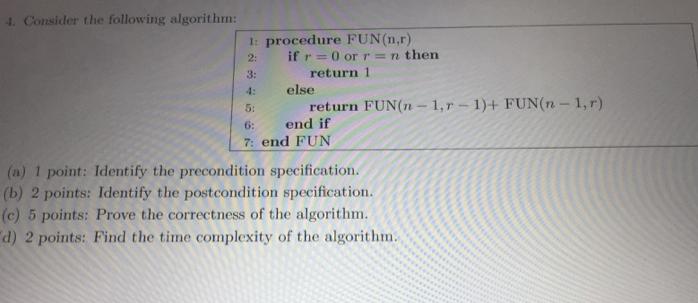Answered step by step
Verified Expert Solution
Question
1 Approved Answer
4. Consider the following algorithm: 2: 1: procedure FUN(n,r) if r = 0 or r= n then return 1 3: else return FUN(n-1,r-1)+ FUN(n-1,r)

4. Consider the following algorithm: 2: 1: procedure FUN(n,r) if r = 0 or r= n then return 1 3: else return FUN(n-1,r-1)+ FUN(n-1,r) end if 5: 6: 7: end FUN (n) 1 point: Identify the precondition specification. (b) 2 points: Identify the postcondition specification. (c) 5 points: Prove the correctness of the algorithm. d) 2 points: Find the time complexity of the algorithm. 4. Consider the following algorithm: 2: 1: procedure FUN(n,r) if r = 0 or r= n then return 1 3: else return FUN(n-1,r-1)+ FUN(n-1, r) end if 5: 6: 7: end FUN (n) 1 point: Identify the precondition specification. (b) 2 points: Identify the postcondition specification. (c) 5 points: Prove the correctness of the algorithm. d) 2 points: Find the time complexity of the algorithm.
Step by Step Solution
★★★★★
3.43 Rating (159 Votes )
There are 3 Steps involved in it
Step: 1
a Identify the precondition specification The precondition specifies the conditions that must be true before the algorithm is executed In this case th...
Get Instant Access to Expert-Tailored Solutions
See step-by-step solutions with expert insights and AI powered tools for academic success
Step: 2

Step: 3

Ace Your Homework with AI
Get the answers you need in no time with our AI-driven, step-by-step assistance
Get Started


